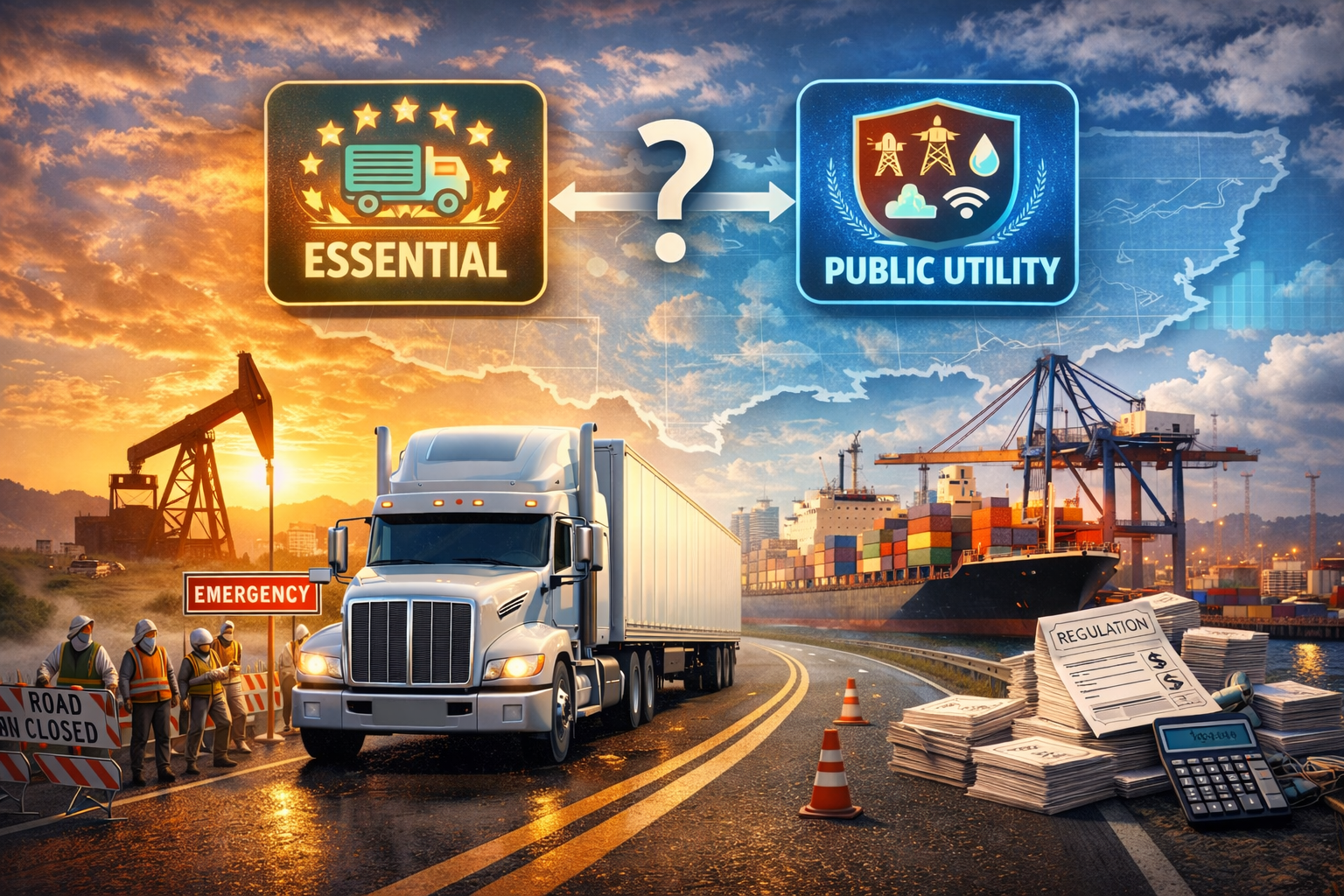What Is IT Like to Own a Trucking Company in Today's Market?
Share this Article:

Owning a trucking company in 2025 is a bold undertaking. You're not just moving freight—you’re operating within one of the most heavily regulated, scrutinized, and legally exposed industries in the U.S. From managing fuel costs to hiring drivers, from DOT audits to accident litigation, trucking company owners must be part strategist, part operator, part compliance expert—and always ready to solve problems.
So, what is it really like to own a trucking company in today’s market? Let’s take a closer look at the opportunities, financial pressures, operational trends, and—importantly—the legal risks facing today’s fleet owners.
The State of the Industry: Profitable, But Precarious
The American trucking industry hauls over 70% of the nation’s freight tonnage—it’s indispensable. But while freight is flowing, operating a fleet is more expensive and complex than ever.
In 2025, the landscape includes:
- Depressed freight rates from overcapacity
- High insurance premiums
- Aggressive legal targeting of carriers after accidents
- Driver shortages and retention challenges
- Expanding regulatory oversight from state and federal agencies
Owning a trucking company may look like a stable business on paper—but beneath the surface, daily decisions carry legal, financial, and reputational risks.
Revenue, Margins, and the Real Numbers
Trucking is a volume-based game. Most small to mid-sized carriers operate on net margins between 4% and 10%, with razor-thin profit per mile. Fuel and wages dominate the cost structure, but legal expenses are increasingly impactful.
Revenue Streams:
- Contract freight
- Spot market loads
- Fuel surcharges
- Brokerage or 3PL services
- Warehousing (for hybrid operators)
Expense Drivers:
- Fuel (25–35%)
- Driver wages and benefits (30–40%)
- Insurance (rising 10–20% year-over-year)
- Legal and litigation costs
- Equipment payments, repairs, and technology
Many owners are learning the hard way that a single lawsuit can wipe out an entire year’s profit—or more.
Truck Accident Liability: A Growing Risk
One of the biggest threats to fleet profitability and survival today is legal exposure from accidents.
Why It’s Getting Worse:
- The rise of nuclear verdicts (jury awards exceeding $10 million)
- Plaintiff attorneys targeting small fleets with weak compliance
- Use of dashcam, telematics, and driver logs as evidence
- Expanded liability for indirect parties, including brokers and shippers
In states like Texas, Florida, and Georgia, aggressive legal environments mean trucking companies can be dragged into multi-year lawsuits even when fault is disputed or shared.
Real-World Impact:
- Higher insurance deductibles
- Lost productivity during investigations or depositions
- Damaged CSA scores and loss of customer contracts
- Owner/operator stress and risk of bankruptcy
If you're not prepared for litigation, you're not ready to run a fleet in 2025.
Regulatory & Insurance Pressures
Regulatory Burden:
Fleet owners must comply with:
- FMCSA regulations (Hours-of-Service, drug testing, equipment standards)
- DOT safety audits and roadside inspections
- HVUT, IFTA, IRP, and multi-state registrations
- Sales tax and FET for equipment purchases
Failure to comply opens the door for lawsuits—especially if records are missing or drivers are improperly classified.
Insurance Costs:
- Annual premiums can exceed $15,000–$25,000 per truck
- High deductibles or self-insured retention models are becoming common
- Insurers increasingly deny coverage for fleets with poor safety records
Many owners are forced to operate with reduced coverage or face non-renewals, exposing them to catastrophic out-of-pocket risks.
Compliance, Taxation, and Risk Management
Owning a trucking company means constantly engaging with regulatory requirements:
1. FMCSA & DOT Compliance
- Hours-of-Service (HOS) enforcement is tight
- ELDs (Electronic Logging Devices) are universal
- Random drug/alcohol tests are required
- Safety scores (CSA) directly impact your ability to win freight
A single violation can spike your insurance costs or make you less attractive to brokers.
2. Sales & Use Tax / Excise Tax
Trucking companies often overpay on sales tax for trucks, trailers, and parts if they’re unaware of exemptions. Owning a fleet requires state-by-state tax knowledge or partnerships with specialty tax consultants.
Additionally, Federal Excise Tax (FET) on new heavy vehicles (12%) remains a major burden—and is currently under IRS review for reform.
3. IFTA, IRP, HVUT, and Multi-State Complexity
You’ll need to manage:
- IFTA fuel tax filings quarterly
- IRP apportioned plates
- HVUT (Form 2290) annually
- Registration and filing in all states where you have “nexus”
This compliance web is time-consuming and costly if mismanaged. Many trucking company owners now outsource these filings to tax professionals.
Freight Markets and Revenue Pressures
Freight demand has normalized post-pandemic, but rate compression remains a serious concern. Digital brokers, large carriers, and AI-powered pricing tools are pressuring small fleets.
You’ll need to balance:
- Spot vs. contract loads
- High-risk vs. low-liability freight
- Volume vs. safety record
Some freight may be profitable—but if it's in high-litigation corridors or requires inexperienced drivers, the long-term legal risk could outweigh short-term gain.
The Driver Management Challenge
Drivers are both your greatest asset—and your biggest liability.
Workforce Challenges:
- Aging driver base (average age: 47+)
- High turnover rates (70%+ in some segments)
- Driver shortages persist, especially in long-haul
- Pressure to hire quickly leads to lower vetting standards
But an unqualified or poorly trained driver is a legal time bomb.
Legal Exposure from Driver Conduct:
- Distracted driving (cell phones, fatigue)
- Hours-of-Service violations
- Poor safety history or license status
- Failure to document pre-trip inspections
Plaintiff attorneys routinely use driver files, training records, and internal communication to prove negligence. Owning a trucking company today means documenting every training session, policy update, and disciplinary action.
Mental Load of Ownership: Compliance Meets Courtroom
Running a trucking business in 2025 requires more than hustle. It demands:
- Constant monitoring of driver behavior
- A legal-minded approach to documentation
- Tech-savviness to manage TMS, ELD, GPS, and AI-based reporting
- Vigilance about accident prevention and post-incident response
One poorly handled accident—or a missed regulatory filing—can trigger a cascade of lawsuits, audits, and lost contracts.
Owning a trucking company isn’t just about logistics. It’s about risk containment.
Using Technology to Reduce Liability
While tech is often seen as a cost center, the right tools can protect you:
Must-Have Solutions:
- Dashcams with forward- and driver-facing lenses
- TMS with driver management, load tracking, and compliance features
- ELD systems integrated with driver coaching and alerts
- Safety analytics platforms to predict risk by driver or lane
- Incident response apps to guide drivers after crashes
Properly deployed, these tools provide defensive evidence, reduce risk, and can lower insurance premiums.
Legal Best Practices for Fleet Owners
To protect yourself and your business, implement:
- Written safety policies
- Documented training programs for all new and existing drivers
- Accident response protocols, including camera footage preservation
- Regular audit of driver qualification files (DQFs)
- Proactive legal consultation before you're sued
Many small fleet owners wait until a claim is filed. In today’s climate, that’s too late. Preventative legal strategy is a must.
How Owners Are Thriving Despite the Risks
Despite challenges, many trucking companies are growing successfully by:
- Focusing on specialized freight (reefer, hazmat, dedicated lanes)
- Building direct shipper relationships (more control, less litigation risk)
- Maintaining pristine safety records and documentation
- Hiring experienced drivers with performance-based incentives
- Partnering with legal, tax, and compliance advisors
Success in 2025 isn’t about being the biggest fleet. It’s about being the smartest operator.
Strategies for Thriving in 2025 and Beyond
To succeed as a trucking company owner in today’s market, consider:
1. Niche Down
Instead of trying to haul anything and everything, build expertise in:
- Reefer freight
- Hazmat
- Construction materials
- Final-mile white glove delivery
Shippers will pay a premium for specialization and reliability.
2. Build Strategic Partnerships
Work directly with shippers, tax consultants, freight brokers, and driver staffing firms to offload administrative weight and focus on growth.
3. Prioritize Cash Flow Over Growth
It’s tempting to add trucks during a market surge—but many go bankrupt due to poor cash flow. Invest in fuel cards, factoring, and lines of credit early to stay liquid.
4. Stay Ahead of Regulation
From emissions rules to labor classification laws, transportation rules are changing fast. Monitor FMCSA updates, state-level taxation trends, and DOT policy changes closely.
Final Thoughts: Ownership in 2025 Is Not for the Faint of Heart
Owning a trucking company in today’s market requires more than just trucks and drivers—it requires resilience, creativity, compliance savvy, and tech fluency. It’s not just about hauling freight; it’s about running a lean, optimized, and legally sound enterprise in one of the most regulated sectors in America.
The barriers to success are high—but so is the demand. If you can navigate the maze, streamline your operations, care for your drivers, and manage your financials with precision, there’s still plenty of money to be made in trucking.
Need help managing compliance, taxes, or scaling operations? Transportation Tax Consulting LLC specializes in helping owners maximize savings, avoid audits, and grow smarter.
Share with Us:




